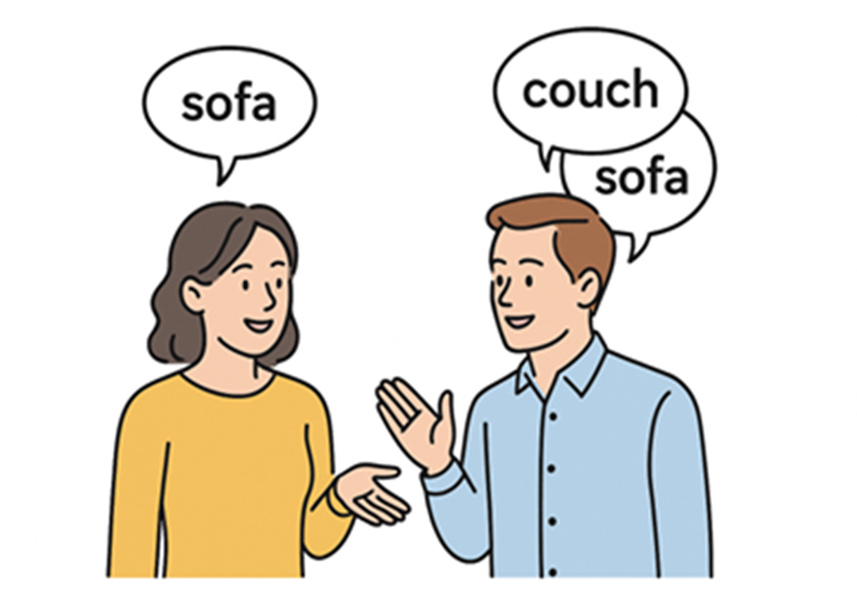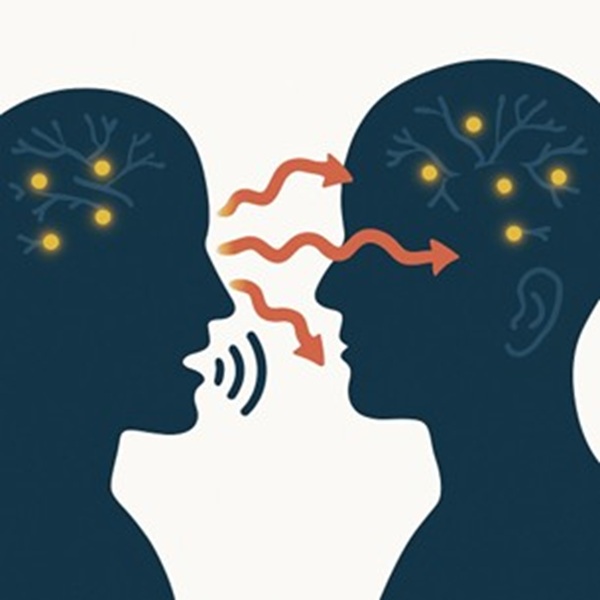Lexical alignment: the art of speaking in sync and how our brain copes with it
Authors: Iqra Ali Mirza, student of the European Master’s in Clinical Linguistics (www.emcl.eu), and Adrià Rofes, assistant professor of Neurolinguistics at the University of Groningen.
Have you ever found yourself spending five minutes talking to someone and suddenly using their words instead of your own? Say, for example, that you usually say “couch” but now suddenly you call it “sofa.” You say “TV,” but suddenly it’s “the telly.” You’ve never in your life referred to dinner as “tea” but after spending time with someone who does say such a beautiful word, “tea” suddenly slips out of your mouth like it’s always been there. You didn’t stop to think about it once. You didn’t decide to change your vocabulary. It just happened. Almost like your brain quietly updated its internal dictionary to match the person you’re speaking with, without seeking your permission (Figure 1).

Scientists refer to this subtle linguistic shift as lexical alignment – the tendency for individuals to unconsciously adjust their word choices to mimic those of their conversational partner 1. Rather than being a deliberate or performative gesture, lexical alignment is an automatic process that facilitates smoother communication between two or more individuals 2.
While lexical alignment often happens seamlessly, it’s not guaranteed. In some neurodevelopmental or neurological conditions, such as autism spectrum disorder or aphasia, lexical alignment can be disrupted. For instance, people on the autism spectrum may find it more difficult to adapt their language to match a partner’s, often due to challenges in predicting others’ intentions or reading subtle conversational cues 3. In such cases, the brain’s alignment system doesn’t switch off entirely. The brain rather does not seem to function in the almost automatic way it does in typical conversations. Studying when and how lexical alignment breaks down enables researchers to understand what’s essential for this process to occur in the first place, and what such a process tells us about communication and cognition.
But why does the brain even bother with this low-key word mimicry?
A lot of it comes down to the brain’s love of efficiency and prediction 4 . Conversations between people may seem effortless, but they’re actually some of the brain’s most demanding work. As we speak and listen, our brains are constantly working behind the scenes, performing a rapid-fire series of guesses to anticipate what’s coming next, not just in terms of ideas, but also in the exact words that might be used 5. When we align our language with our conversational partner, we make that job easier. Shared words mean less mental decoding, fewer chances for confusion, and a smoother conversational rhythm. It’s like both speakers are reading from the same script, even if neither one wrote it down!
This process of lexical alignment helps create what Pickering and Garrod 6 refer to as a shared mental model, a sort of mutual map of the conversation that both speakers are navigating together. With that shared map in place, comprehension becomes faster, and it is less prone to detours. Lexical alignment also reduces the likelihood of miscommunication, because both individuals are drawing from the same pool of linguistic references. You could see lexical alignment as more of a cognitive shortcut. It’s your brain saying: “Why argue over couch vs. sofa when we can just get to the point and call it the same thing?”. As it turns out, being “on the same page” isn’t just a figure of speech; it’s good for getting things done. Studies have shown that when people align their language more, they tend to be more successful. This phenomenon occurs whether they’re working alone, in pairs, or as part of a team 7.
Lexical alignment isn’t just about words. It turns out, our brains sync up too
Neuroscientists have found that during conversation, the brain activity of the speaker and the listener starts to mirror one another 8. In a well-known study conducted at Princeton University by Stephens et al. 9, participants’ brains were scanned using fMRI while they listened to spoken stories. Researchers found that the better the listener understood the story, the more closely their brain activity and the lit-up regions on the scan matched the speaker’s. It’s like brain-to-brain Wi-Fi, and the signal gets stronger when the words match (Figure 2)!

And it’s not just humans we’re aligning with any more
As Artificial Intelligence (AI) continues to find its way into our daily lives, whether through chatbots, voice assistants, or customer service bots, we’re starting to see signs of lexical alignment between humans and non-humans too. People often adjust their language when talking to machines, especially if the AI mirrors their phrasing 10. As artificial intelligence gets better at sounding human, lexical alignment could be one of the reasons we find ourselves talking to machines as if they’re just another person 11. It’s becoming harder to tell whether we’re aligning with a human or just a very convincing machine.
In sum: lexical alignment happens all the time, you don’t really have to be in a lab to spot it. Couples often end up using the same pet names, friends adopt each other’s slang, and even workplace teams develop shared vocabulary over time. It happens in texts, group chats, and even meme culture. It is a bit like the ultimate social superpower: it prepares us to blend in and build bonds between one another and even between humans and machines! So, the next time you find yourself sipping “tea” instead of eating dinner, just embrace it. Trust me, you’re not copying, you’re connecting.
References
- Brennan, S. E., & Clark, H. H. (1996). Conceptual pacts and lexical choice in conversation. Journal of Experimental Psychology, Learning, Memory, and Cognition, 22(6), 1482–1493. https://doi.org/10.1037//0278-7393.22.6.1482 ↩
- Menenti, L., Pickering, M. J., & Garrod, S. C. (2012). Toward a neural basis of interactive alignment in conversation. Frontiers in Human Neuroscience, 6. https://doi.org/10.3389/fnhum.2012.00185 ↩
- Stabile, M., & Eigsti, I.-M. (2022). Lexical Alignment and Communicative Success in Autism Spectrum Disorder. Journal of Speech, Language, and Hearing Research, 65(11), 1–6. https://doi.org/10.1044/2022_jslhr-22-00314 ↩
- Pickering, M. J., & Garrod, S. (2013). An integrated theory of language production and comprehension. Behavioral and Brain Sciences, 36(4), 329–347. https://doi.org/10.1017/s0140525x12001495 ↩
- Dikker, S., & Pylkkänen, L. (2013). Predicting language: MEG evidence for lexical preactivation. Brain and Language, 127(1), 55–64. https://doi.org/10.1016/j.bandl.2012.08.004 ↩
- Pickering, M. J., & Garrod, S. (2004). Toward a mechanistic psychology of dialogue. Behavioral and Brain Sciences, 27(02). https://doi.org/10.1017/s0140525x04000056 ↩
- Reitter, D., & Moore, J. D. (2014). Alignment and task success in spoken dialogue. Journal of Memory and Language, 76, 29–46. https://doi.org/10.1016/j.jml.2014.05.008 ↩
- Ilmberger, J., Eisner, W., Schmid, U., & Reulen, H.-J. (2001). Performance in Picture Naming and Word Comprehension: Evidence for Common Neuronal Substrates from Intraoperative Language Mapping. Brain and Language, 76(2), 111–118. https://doi.org/10.1006/brln.2000.2415 ↩
- Stephens, G. J., Silbert, L. J., & Hasson, U. (2010). Speaker-listener neural coupling underlies successful communication. Proceedings of the National Academy of Sciences, 107(32), 14425–14430. https://doi.org/10.1073/pnas.1008662107 ↩
- Shen, H., & Wang, M. (2023). Effects of social skills on lexical alignment in human-human interaction and human-computer interaction. Computers in Human Behavior, 43, 107718. doi: 10.1016/j.chb.2023.107718 ↩
- Srivastava, S., Wentzel, S. D., Catala, A., & Theune, M. (2025). Measuring and implementing lexical alignment: A systematic literature review. Computer Speech & Language, 90, 101731. doi: 10.1016/j.csl.2024.101731 ↩